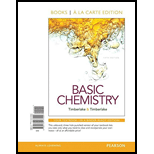
Concept explainers
(a)
Interpretation:
To determine the given Haworth structure as the a or the ß form.
Concept Introduction:
D- Fructose is a monosaccharide with the chemical formula C6H12O6. A Haworth structure is a common way to write the structural formula of a given monosaccharide in the cyclic form with a simple 3-D perspective. The beta position in case of D-Fructose refers to the projection of -OH group on the same side on carbon number 6. This further results in upwards projection of hydroxyl group present on carbon number 2. Alpha configuration, on the other hand can be observed when there is downward projection of hydroxyl group on carbon number 2.
(b)
Interpretation:
To determine the given Haworth structure as the a or the ß form.
Concept Introduction:
D- Glucose is a monosaccharide with the chemical formula C6H12O6. A Haworth structure is a common way to write the structural formula of a given monosaccharide in the cyclic form with a simple 3-D perspective. The beta position in case of D-glucose refers to the projection of -OH group on carbon no.1 above the plane of the ring Alpha configuration, on the other hand can be observed when there is downward projection of hydroxyl group on carbon No. 1.
Want to see the full answer?
Check out a sample textbook solution
Chapter 18 Solutions
Basic Chemistry, Books a la Carte Edition (5th Edition)
 ChemistryChemistryISBN:9781305957404Author:Steven S. Zumdahl, Susan A. Zumdahl, Donald J. DeCostePublisher:Cengage Learning
ChemistryChemistryISBN:9781305957404Author:Steven S. Zumdahl, Susan A. Zumdahl, Donald J. DeCostePublisher:Cengage Learning ChemistryChemistryISBN:9781259911156Author:Raymond Chang Dr., Jason Overby ProfessorPublisher:McGraw-Hill Education
ChemistryChemistryISBN:9781259911156Author:Raymond Chang Dr., Jason Overby ProfessorPublisher:McGraw-Hill Education Principles of Instrumental AnalysisChemistryISBN:9781305577213Author:Douglas A. Skoog, F. James Holler, Stanley R. CrouchPublisher:Cengage Learning
Principles of Instrumental AnalysisChemistryISBN:9781305577213Author:Douglas A. Skoog, F. James Holler, Stanley R. CrouchPublisher:Cengage Learning Organic ChemistryChemistryISBN:9780078021558Author:Janice Gorzynski Smith Dr.Publisher:McGraw-Hill Education
Organic ChemistryChemistryISBN:9780078021558Author:Janice Gorzynski Smith Dr.Publisher:McGraw-Hill Education Chemistry: Principles and ReactionsChemistryISBN:9781305079373Author:William L. Masterton, Cecile N. HurleyPublisher:Cengage Learning
Chemistry: Principles and ReactionsChemistryISBN:9781305079373Author:William L. Masterton, Cecile N. HurleyPublisher:Cengage Learning Elementary Principles of Chemical Processes, Bind...ChemistryISBN:9781118431221Author:Richard M. Felder, Ronald W. Rousseau, Lisa G. BullardPublisher:WILEY
Elementary Principles of Chemical Processes, Bind...ChemistryISBN:9781118431221Author:Richard M. Felder, Ronald W. Rousseau, Lisa G. BullardPublisher:WILEY





